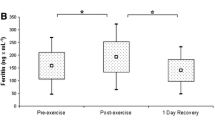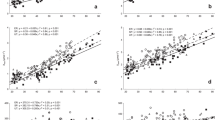Summary
Erythropoietic adaptations involving the oxygen dissociation curve (ODC) and erythropoietin production have been implicated in the etiology of reduced blood haemoglobin concentrations in sportspersons (known as sports anaemia). A significant increase in the half-saturation pressure indicating a right-shift in the ODC was measured in 34 male [25.8–27.4 mmHg (3.44–3.65 kPa)] and 16 female (25.8–27.7 mmHg (3.44–3.69 kPa)] trained distance runners (P<0.01 for both genders) after completing a standard 42-km marathon. Erythrocyte 2,3-diphosphoglycerate concentrations measured concurrently were unaltered by exercise, although consistently higher in the female compared to the male athletes (P<0.05). The serum erythropoietin (EPO) concentrations of 15 male triathletes (26.3 U · ml−1) were significantly lower than those of 45 male distance runners (31.6 U · ml−1 ;P<0.05). However, the mean serum EPO concentrations of male and female athletes engaged in a variety of sports were not different from those of sedentary control subjects of both sexes (26.5–35.3 U · ml−1). Furthermore, the serum EPO concentrations were unaltered after prolonged strenuous exercise in 20 male marathon runners. These data suggest that the haematological status of these endurance athletes is in fact normal and that the observed shift in the ODC, while providing a physiological advantage during exercise, has no measurable effect on the erythropoietic drive.
Similar content being viewed by others
References
Berglund P, Birgegard G, Hemmingson P (1988) Serum erythropoietin in cross-country skiers. Med Sci Sports Exerc 20:208–209
Böning D, Schweigart U, Tibes U, Hemmer B (1975) Influences of exercise and endurance training on the oxygen dissociation curve of blood underin vivo andin vitro conditions. Eur J Appl Physiol 24:1–10
Bonner HW, Tate CA, Buffington CK (1975) Changes in erythrocyte 2,3-DPG in women following short-term maximal exercise. Eur J Appl Physiol 34:227–232
Boswart J, Kuta I, Lisy Z, Kostiuk P (1980) 2,3-diphospho-glycerate during exercise. Eur J Appl Physiol 42:193–199
Braumann KM, Boning D, Trost F (1979) The oxygen dissociation curve in trained and untrained subjects. Eur J Appl Physiol 42:51–60
Braumann KM, Boning D, Trost F (1982) Bohr effect and slope of the oxygen dissociation curve after training. J Appl Physiol 52:1524–1529
Brewer GJ (1974) 2,3-DPG and erythrocyte oxygen affinity. Ann Rev Med 25:29–38
Brodthagen UA, Hansen KN, Kundsen JB, Jordal R, Kristensen O, Paulev P-E (1985) Red cell 2,3-DPG, ATP and mean cell volume in highly trained athletes. Effect of long-term, submaximal exercise. Eur J Appl Physiol 53:334–338
Dempsey JA, Rodriguez J, Shadidi NT, Reddan WG, MacDougall L (1971) Muscular exercise, 2,3-DPG and oxyhemoglobin affinity. Int Z Angew Physiol 30:34–39
De Paoli Vitali E, Guglielmini C, Casoni I, Vedovato M, Gilli P, Farinelli A, Salvatorelli G, Conconi F (1988) Serum erythropoietin in cross-country skiers. Int J Sports Med 9:99–101
Faulkner J, Brewer G, Eaton J (1970) Adaptation of the red blood cell to muscular exercise. Adv Exp Med Biol 6:213–225
Fried W, Morley C (1985) Update on erythropoietin. Int J Art Org 8:79–82
Garcia JF, Sherwood JB, Goldwasser E (1979) Radio-immunoassay of erythropoietin. Blood 5:405–410
Hallberg L, Magnusson B (1984) The etiology of ‘sports anemia’: a physiological adaptation of the oxygen dissociation curve of hemoglobin to an unphysiological exercise load. Acta Med Scand 216:145–148
Irving RA, Noakes TD, Burger SC, Myburth KH, Querido D, van Zyl-Smit R (1990) Plasma volume and renal function during and after ultra-marathon running. Med Sci Sports Exerc 22:581–587
Keitt AS (1971) Reduced nicotinamide adenine dinucleotidelinked and fluorometric procedures. J Lab Clin Med 77:470–475
Kinski H, Sztobryn M (1976) The effect of physical exercise on 2,3-DPG concentrations in erythrocytes. Acta Physiol Pol 27:293–299
Klein JP, Forster HV, Stewart RD, Wu A (1980) Hemoglobin affinity for oxygen during short-term exhaustive exercise. J Appl Physiol 48:236–242
Kostuk WK, Suwa K, Bernstein EF, Sobel BE (1973) Altered haemoglobin oxygen affinity in patients with acute myocardial infarction. Am J Cardiol 31:295–299
Pagel H, Jelkmann W, Weiss C (1989) O2 supply to the kidneys and the production of erythropoietin. Respir Physiol 77:111–117
Remes K, Harkonen N, Vuopio P (1975) The decrease in red cell 2,3-DPG concentration in long distance running. J Sports Med 15:113–116
Ricci G, Masotti M, De Paoli Vitali E, Vedovato M, Zannotti F (1988) Effects of exercise on hematologic parameters, serum iron, serum ferritin, red cell 2,3-diphosphoglycerate and creatine contents, and serum erythropoietin in long-distance runners during basal training. Acta Haematol (Basel) 80:95–98
Rowan RM, Fraser C, Gray JH, McDonald GA (1979) The Coulter Counter Model S Plus — the shape of things to come. Clin Lab Haematol 1:29–40
Schmidt W, Maassen N, Trost F, Boning D (1988) Training induced effects on blood volume, erythrocyte turnover and haemoglobin oxygen binding properties. Eur J Appl Physiol 57:490–498
Schmidt W, Eckardt KU, Hilgendorf A, Strauch S, Bauer C (1991) Effects of maximal and submaximal exercise under normoxic and hypoxic conditions on serum erythropoietin level. Int J Sports Med 12:457–461
Shaklai N, Benitez L, Ranney HM (1978) Binding of 2,3-DPG by spectrin and its effect on oxygen affinity of haemoglobin. Am J Physiol 234:C36-C40
Shappell SD, Murray JD, Nasser MG, Wills RE, Torrance JD, Lenfant CJM (1970) Acute changes in haemoglobin affinity for oxygen during angina pectoris. N Eng J Med 282:1219–1224
Siegal S (1976) Non-parameterc statistics for the behavioural sciences. McGraw-Hill, Kogakisha, Japan
Taunton G, Taunton T, Banister E (1974) Alterations in 2,3-DPG and P50 with maximal and submaximal exercise. Med Sci Sports 6:238–241
Vedovato M, De Paoli Vitali E, Guglielmini C, Casoni I, Ricci G, Masottie M (1988) Erythropoietin in athletes of endurance events. Nephron 48:78–79
Weight LM, Jacobs P, Byrne MJ (1991a) The haemolysis of exercise. Clin Sci 81:147–152
Weight LM, Klein M, Noakes TD, Jacobs P (1992) ‘Sports anaemia’ — a real or apparent phenomenon in endurance-trained athletes. Int J Sports Med (in press)
Weight LM, Alexander D, Elliott T, Jacobs p (1991c) Athletes pseudo-anemia. Eur J Appl Physiol 62:358–362
Woodson R, Wranne B, Detter J (1982) Effect of erythrocyte 2,3DPG and hemoglobin concentration on oxygen delivery and work performance. Clin Res 20:268–272
Author information
Authors and Affiliations
Rights and permissions
About this article
Cite this article
Weight, L.M., Alexander, D., Elliot, T. et al. Erythropoietic adaptations to endurance training. Europ. J. Appl. Physiol. 64, 444–448 (1992). https://doi.org/10.1007/BF00625065
Accepted:
Issue Date:
DOI: https://doi.org/10.1007/BF00625065




